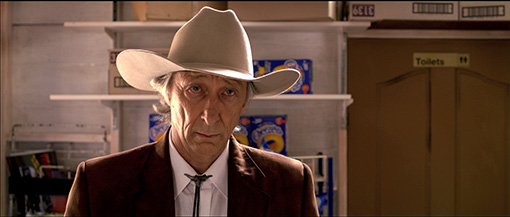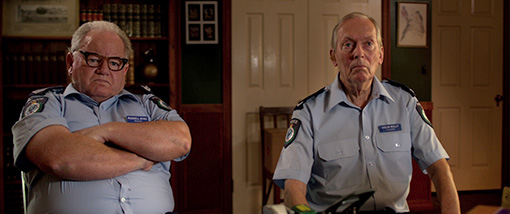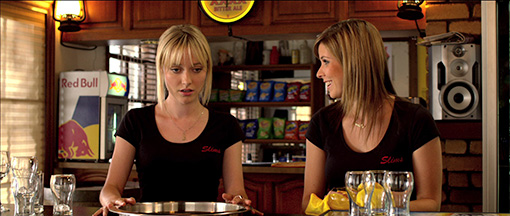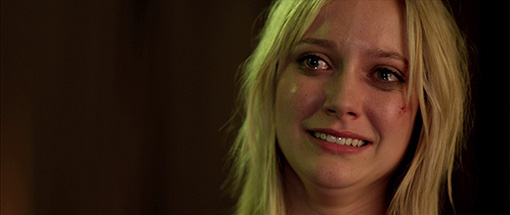|
There's a lot to be said for interesting faces, something too rarely considered by Hollywood when looking for a short-cut to character engagement. They tend to like their movie and TV characters to look good – if American TV is to be believed, superficial prettiness is a pre-requisite for working for any branch of health, law enforcement or the legal profession. This is probably why the bad guys in such shows are usually more interesting than the heroes, though even they tend to be cast from conventional moulds. If you want really interesting film faces then you need to look to Europe, or better still Eastern Europe. Or maybe even down under. Or in the case of the first and best of the great faces here, a little bit of both.
A man walks into a garage. This is not the first line of a hoary old joke, but the film's opening scene. It may not sound like much, but plays like a bigger deal than it initially proves to be. At first we only see the man in question from behind as he carefully dons a Stetson and enters the garage to a musical portent of dramatic doom, which is hilariously undercut when the score suddenly halts and the garage owner lets out a small surprised "oh!" of realisation that someone is standing before him. That's when we first see the face of a man who will only ever be known as The Stranger, and it's really rather wonderful. Gaunt, squint-eyed and sporting an East European accent, he looks and sounds a little like a late-career Robert Mitchum's hungrier Croatian cousin. He's stopped here because of a knocking sound in his car that he wants the garage owner to take a look at. The man reluctantly obliges, then overcharges for his time. The Stranger responds by shooting him in the face.

We're then introduced to pretty young Marilyn, a diner waitress who's expecting her boyfriend to propose to her that evening. He's been away for a few days on business and is coming back tonight with the engagement ring. At this point our Marilyn is not all that interesting, but help is at hand in the shape of mature man-eater Eileen (Lynda Stoner from Prisoner: Cell Block H) and the bar's world-weary owner Slim (an engagingly sleazy turn by Paul Holmes), who at this very moment is paying off The Stranger for killing the man at the garage. His work here complete, The Stranger drives away, but on a dark road at night he is reaching in the glove box for a bag of cocaine given to him by Slim when...
It's worth noting here that Crawl is not big on narrative complexity. That's not meant as a criticism, just a justification for revealing no more of a storyline whose principal pleasure comes from the manner in which it unfolds, although we're not exactly in virgin territory here. If you've not joined the cinematic influence dots by the time the above plot summary fades out, then you should be able to a few minutes later. Yep, Crawl has the Coen Brothers and specifically Blood Simple written all over it. As it turns out, this is no bad thing. In the post-film generation age, when just about every new young filmmaker is influenced by and cheerfully borrows from the filmmakers whose work they grew up with, precious few have attempted to walk the distinctive path laid by the Coens, and even fewer (I'm struggling to name one) have done so as confidently as Paul and Benjamin China. Hang on a sec. The China Brothers. One directs, the other produces. Now where have I heard that before?
There's no question that in many ways Crawl plays a little like Blood Simple light, lacking the twisted narrative and flair for the quirkily grotesque that so distinguished the Coens' deliciously dark debut. But the China brothers have learned much from their adopted mentors, in their carefully crafted framing choices, the tension-building use of slow dolly shots, the flashes of dark humour, the unhurried pacing, and the eye for offbeat detail. The casting in particular is largely spot-on, and it needs to be in a film in which whole scenes play in silence or with the minimum of dialogue. As the enigmatic Stranger (a hired gun dressed in cowboy apparel and sporting an accent that casts him instantly as an outsider, he really is The Man With No Name), actor George Shevtsov just radiates quietly threatening enigma, his age and weathered features suggesting a man with the collective experience to handle any situation rather than one past his prime. As the romantically hopeful Holly, Lauren Dillon is initially a bit of a blank sheet and given little to work with, but really shows her metal when required to communicate desperation and fear through her facial expression and body language alone. And as offbeat supporting characters go, Paul Bryant and John Rees-Osborne are an unfussy delight as the gruffly rotund Sergeant Byrd and the taciturn Constable Rolly, local cops who feel somehow closer to the real deal than the salon-groomed mannequins of a hundred American police dramas.

Technically the film has a polish that most first-timers can only dream of, thanks in no small part to the fortuitous recruitment of respected cinematographer Brian J. Breheny, who shot The Adventures of Priscilla, Queen of the Desert and The Other Side of Heaven, and whose RED camera scope compositions here are never less than pristine. Adding a further layer of quality is composer Christopher Gordon (he of Master and Commander: The Far Side of the World), whose portentous bass strings make this small indie film at times feel like it's been biologically welded to a big budget studio thriller from the late 1950s. It's an initially disorientating marriage of styles that actually works a treat and helps give the film its specific identity, one that is open about its influences (everything from The Shining to The Texas Chain Saw Massacre to Once Upon a Time in the West are referenced here) but seamlessly integrates them into the precision-tooled whole.
In narrative terms at least, the final act may not take us anywhere that new – an attractive young woman is menaced in her home by a sinister killer; a potential rescuer fails to see the killer walk up behind him – but it does so with style and a seductive blend of menace and understatement, culminating in ending that is open to literal and metaphoric interpretations. It's an ambiguous but strangely satisfying conclusion to a strikingly confident first feature that bodes well for future projects from this familial filmmaking duo.
Shot on the Red One MX with (borrowed) Cooke 5/i lenses at an aspect ratio of 2.35:1, at it's best the Blu-ray transfer here is lovely enough to eat. Daylight colours are vivid but naturalistic (oh hallelujah), the contrast punchy without aggressively sucking in shadow detail and the black levels that are so important to night-time noir are rock solid throughout. The sharpness and overall richness of the image delivered by the Red One never feels artificially enhanced and coupled with Brian's Breheny's lighting camerawork, gives the film a look and feel that belies its low budget and 25-day shoot.

The soundtrack is a DTS-only affair, with DTS-HD Master Audio 5.1 surround auto-selected for those with HD compatible amp and regular DTS 5.1 surround provided for the rest (I'm not sure what happens if you don't have a DTS-enabled amp). The clarity and range are well up to the expected standard for a modern thriller, and while the film's low-key approach and use of silence never makes this a show-off track, the bass strings of the score and the occasional sharp sound effect are sufficiently attention-grabbing. The use of surrounds is subtle, though occasionally a little odd – on a wide shot of The Stranger's car as it drives towards the camera at the start of chapter 5, the sound of the vehicle can be heard clearly from behind as well as the front.
Commentary
An animated and enjoyable audio commentary in which Paul and Benjamin China are joined by genre specialist, FrightFest co-organiser and enthusiast for the film Alan Jones, who proves an excellent feed man, asking all the right questions and prodding the brothers for information that they might otherwise not have touched on. There's a lot covered here in sometimes enthralling detail, including how English twin brothers ended up living and making a film in Australia, how the budget impacted their choice of locations (the garage, the bar and Slim's office were all constructed in Marilyn's house), the references to other films (Let the Right One In, Rear Window and Polanski's The Fearless Vampire Killers are among the surprises), the differences between the original project (titled "Howl") and the final film, the spanking scene (oh yes), the visual style, and a lot more. My only complaint is that the film soundtrack is a sometimes little too loud – when the music kicks in it comes close to completely overpowering the commentary.
FrightFest Interviews (12:23)
If you're not a fan of commentaries (and you are, aren't you?), then you'll find a severely condensed version of the one above here, as Alan Jones asks many of the same questions he covered in the commentary, for which the China brothers provide concise and animated answers. There also a brief intro to the UK premiere at Glasgow FrightFest, and an amusing observation from an audience member after the screening.

Cast Interviews (4:45)
Brief interviews with cast members Paul Holmes (Slim), Georgina Haig (Marilyn) and George Shevtsov (The Stranger) that focus their views of the characters they play. There are some minor microphone issues on the first interview and the first two conclude with the results of the actors being prompted to quickly sell the film, presumably without being given time to think of a decent response ("It'll make you laugh, it'll keep you on the edge of your seat..."). My favourite comment of all comes from the likeable Paul Holmes – asked how Crawl differs from other Australian films, he quickly responds, "Bill Hunter's not in it."
Trailer (2:12)
Lots of suggestive clips and critical accolades, all cut to the wrong music (with a score as good as this, why wouldn't you use it?). The quick-cut nature of trailers means that while it captures the essence of the plot, it fails to communicate just what makes the film so distinctive, and it does give a bit too much away for my liking.
Already making waves on the festival circuit, the China Brothers' stylish and atmospheric debut borrows productively from the Coen Brothers, spices the pie with a string of subtle references to other films, and makes its characters the prime focus for incident and narrative development. The plot may be a tad anaemic, but the handling and performances alone make Crawl distinctive enough to have me keen to see what the China boys will do next. Arrow's Blu-ray sports a spanking transfer, an informative and engaging commentary and a well-handled interview that puts faces to the names and voices. Recommended. |